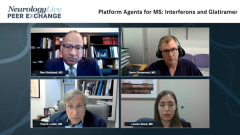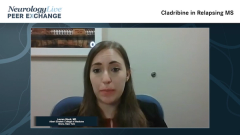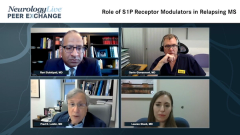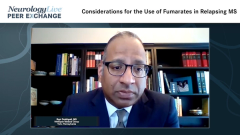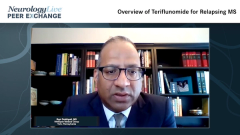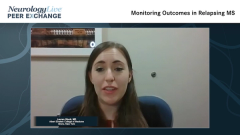
Role of S1P Receptor Modulators in Relapsing MS
Expert neurologists discuss the role of sphingosine-1-phosphate (S1P) receptor modulators in relapsing multiple sclerosis including vaccine considerations and pediatric use.
Episodes in this series

Fred D. Lublin, MD: Let’s move onto our most dynamic class of agents. We now have 4 of them and those are the sphingosine-1 phosphate modulators [S1P]. We started with fingolimod [Gilenya] in 2010 and now we have the next generation of S1P selective modulators. Ravi, why don’t you take us through these?
Ravi Dukkipati, MD: Sure. Thank you. The S1P modulators are well established in the MS [multiple sclerosis] treatment space. They were the first oral mainstream therapies approved, with fingolimod being approved in 2010, followed by siponimod [Mayzent], ozanimod [Zeposia], and ponesimod [Ponvory]. I think they’ve established themselves well as high efficacy oral therapies. The newer iterations—siponimod, ozanimod, and ponesimod—offer increased selectivity in terms of the S1P receptor subtypes. Fingolimod’s mechanism of action is predominantly on all 5 subtypes of the S1P receptor, whereas the newer iterations, siponimod and ozanimod, are more selective. Ponesimod is the most recent entrant and primarily exerts its effect on S1P1 receptors. The newer S1P modulators, in a nutshell, emulate the efficacy— which already well demonstrated both short-term and long-term—while improving safety and tolerability. By increasing selectivity, the newer S1P agents don’t need first dose monitoring as, for example, fingolimod does. The pivotal studies for ozanimod and ponesimod demonstrated some novel outcome measures: trying to tease out brain atrophy and cognition data, and other markers including patient reported fatigue. I think the bottom line is that this class is here to stay. In a sense, that’s why it’s increasingly crowded. In place of the legacy or the term that you don’t prefer to use, platform agents, these are the new platform agents. We go from there. But to summarize, they offer optimum efficacy and are reasonably safe. The newer ones offer more selectivity, which may impart better safety and tolerability profiles. One more recent development that has casted concern is vaccine readiness. I would like to hear what your thoughts are on that.
Fred D. Lublin, MD: Yes, the vaccine issue is an interesting one. There’s a report from Israel that showed people on S1P had almost no response, or very low response. We just sent something into ECTRIMS [European Committee for Treatment and Research in Multiple Sclerosis] with a different result, so I can’t go through the data now. We don’t see that concern in the S1Ps. Anti-CD20 [monoclonal antibodies] is a different story. Lauren, thoughts about the safety of this group and the pediatric indication?
Lauren Gluck, MD: Sure. Taking the second part first, fingolimod is the only MS DMT [disease-modifying therapy] with a FDA [Food and Drug Administration] approval for pediatrics, which doesn’t limit us from using other DMTs but is a great reassurance, especially in terms of safety. Because these are overwhelmingly safe, especially in regard to day-to-day adverse effects. Most people don’t have adverse effects. It’s wonderful. Most commonly, in the trials, people complained of headache or sore throat, and, obviously, the lab abnormalities we see. Adverse effects require monitoring with transaminitis and with lymphopenia. But there are signals for strange, opportunistic infections. Things like CMV [cytomegalovirus], meningitis, and disseminated zoster are very rare but diseases to acknowledge if a patient starts complaining of severe headaches or strange rashes. The 1 thing I’ll tack on is that as I’ve shifted toward the newer version of the S1Ps. I’ve noticed a lot of their trial outcome measures focus on cognition, and patients often ignore the reality that MS can not only cause physical disability, but cognitive disability as well. Bringing that to the forefront of discussion is very important and sometimes helps convince patients the gravity of why they need to start early treatment and how physical isn’t the only disability that can be a problem in the future.
Fred D. Lublin, MD: OK.
Gavin Giovannoni, MD: Fred, could I just add a few caveats? One of the problems about the S1Ps is pregnancy. You can’t be pregnant while taking them because of the teratogenicity risk and, at least with fingolimod—as I would imagine it’s going to be similar with other agents— because of the rebound phenomenon. When you wash the drug out, there’s potential for severe recurrence of activity. I personally feel negatively for the class. Particularly because most people with MS tend to be young women. When they present, I don’t want to use S1Ps in young women, who are planning families because of the issues around pregnancy, having to stop treatment, and the rebound. The other 1 is also the older population. You know S1P is a chronic immunosuppressant, and I know it’s not as potent of an immunosuppressant but we’ve seen, for example, a large number of cases of warts, some strange fungal dermatitis, and a cryptococcal meningitis in our center in the Blizard Institute, Barts and The London School of Medicine and Dentistry in London, United Kingdom. Although it isn’t a big signal, there is worry that in the older population, where immune senescence is a concern, you may see more opportunistic infections and potential malignancy signals. The signals of the basal cells, squamous carcinoma, the lymphoma are quite clear now. Yes, it is a good drug class but there are certain populations that I would steer away from using them in.
Fred D. Lublin, MD: Yes. Of course, we don’t know about the rebound effect on the ones with the shorter half-life, like siponimod and ponesimod, yet. You discussed a bit about natalizumab [Tysabri], which we’re not spending a lot of time on, but you have the same sort of issues where you have to consider rebound. When you start someone on that, you want to plan on continuing that treatment. Of course, the best way of avoiding rebound is rapidly switching to another agent if you must stop. Pregnancy is a different issue.
Gavin Giovannoni, MD: Did you see that case report, which was just published about 3 weeks ago, of a patient that was switched from fingolimod to siponimod because they had secondary progressive MS? There wasn’t any wash out, but he or she went from fingolimod to siponimod and developed profound rebound, which makes you think that fingolimod may have a different profile compared to siponimod because we know it works on more receptors. There’s S1P1, 3, 4, and 5. Siponimod is 1 and 5. There’s more to this class of agents than just lumping these agents together. I suspect there are going to be some subtleties regarding the mode of action.
Fred D. Lublin, MD: Interesting point. We thank our audience for watching this Neurology Live® webinar. If you enjoyed the content, please subscribe to our e-newsletter to receive upcoming programs and other great content right in your inbox.
Transcript Edited for Clarity
Newsletter
Keep your finger on the pulse of neurology—subscribe to NeurologyLive for expert interviews, new data, and breakthrough treatment updates.


